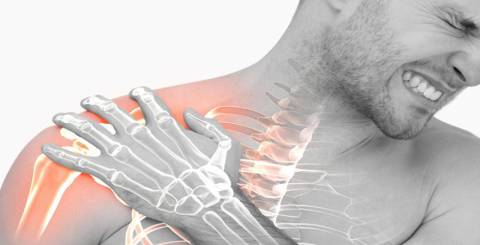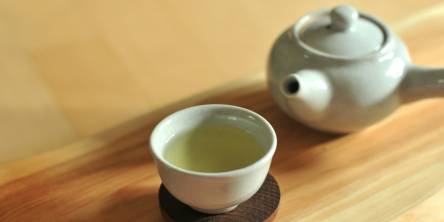Frozen Shoulder - Causes, Symptoms and Natural Treatment

What is Frozen Shoulder?
Frozen shoulder is also known as adhesive capsulitis. This disorder is a very common disorder in general orthopedic practice, it can happen due to hormonal imbalance, diabetes, injury and chronic health condition like arthritis when the shoulder becomes loosen.
Pain in the shoulder leads to stiffness and loss of a range of motion in the area of the shoulder. Range of motion can be usually treated with heating the area, some light stretching exercises, physical therapy (which should be guided by doctors or physical therapist) and non-steroidal anti-inflammatory drugs.
The frozen shoulder is thought to happen when scar tissue forms in the shoulder and this causes the shoulder joint's capsule to thicken and tighten, leads to difficulty in movement. The joint of the shoulder has a very loose joint capsule of connective tissue, it is called articular capsule of the humerus.
It commonly affects the adults in the age group of 40 to 60; particularly women are more likely to have this sort of problem than men. It can be a scary experience and slowly move forward towards severe condition, which can limit the functioning of your arm. The tightness and pain in the shoulder may even make it difficult to perform day to day routine work which requires movement in the shoulder.
Shoulder Anatomy
The most complex and largest joint in the human body is Shoulder when the upper arm (humerus) bone fits the shoulder blade (scapula) and the clavicle (Collar bone). The shoulder joint is itself is a Glenohumeral joint.
The shoulder is made up of 3 bones.
- The shoulder blade or scapula
- The collarbone or clavicle and
- The upper arm bone or humerus
The shoulder has a ball-and-socket joint between the head of the humerus and the glenoid cavity of the scapula.
The round head of the upper arm bone fits tightly into the socket.
The Connective tissue, known as the shoulder capsule that attaches muscles to bone. It surrounds the Synovial fluid which enables the joint to move with no friction.
The Signs and Symptoms of Frozen Shoulder
When the shoulder capsule tightens, it becomes stiff and thick. The signs of the condition are mild to severe and the patient is unable to move the shoulder. It typically develops slowly, and in three stages. Each stage can be last for months
- FREEZING STAGE: The movement of the shoulder causes pain and the range of motion starts to become limited and typically lasts for 6 weeks to 9 months approx.
- FROZEN STAGE: The symptoms actually improve during this stage. However, your shoulder becomes stiffer. During 3 to 5 months of the frozen stage, daily activities may be very difficult.
- THAWING STAGE: The shoulder motion begins to improve, returns to normal and close to normal strength, this stage typically takes 6 months to 2 years depending upon the seriousness of the condition.
Natural Treatments for Frozen Shoulder
- Some doctors choose to cure some most painful and severe cases of frozen shoulder with steroids, painkillers and sometimes even with arthroscopic surgery to loosen the stiff and inflamed joint capsule and resolve the underlying condition to prevent pain from returning.
- A natural approach to return the normal condition involves gradually improving range of movement through gentle physical exercises, stretching the shoulder and natural pain killing treatments which can help to lower the inflammation
1.HOT COMPRESSION: Before starting exercises for frozen shoulder, make sure to warm your shoulder to boost blood circulation in the affected shoulder to be sure not to get any further injury.
2. Exercises to improve mobility of shoulder: After warming the shoulder and deep breathing, some sort of stretching and moving can help to ease the pain and stiffness but need to be backed off after feeling considerable pain:
PENDULUM STRETCH: Stand up and the shoulders should be relaxed. Lean forward with the hand of the unaffected arm resting on a table. Let the affected arm hang down and swing in a small circle for about 10 times in each direction(clockwise and anti-clockwise), around 1 foot in diameter. Increase the speed over several days of practice, as you gain strength and add more repetitions of the exercise. Little weight should be given to the hand to accelerate the healing.
ARMPIT STRETCH: Place your affected arm on a shelf of the height till your chest area. Slightly bend and straighten your knees to stretch the armpit. Try bending your knees deeper
TOWEL STRETCH: Take a small towel of around 3 feet, lean towards your back while holding each side in your hand. Use your good arm to pull the affected arm to stretch it upwards. Try to do it for 10 – 20 times
OUTWARD ROTATION: This strengthening and rotation exercise add resistance and when you start doing it, the mobility increases. Hold a rubber exercise band between your hands and the elbow should be on 90- degree to the lower part of the affected arm, rotate outward three or four inches and hold for about five seconds. Try repeating it 10 to 20 times a day.
INWARD ROTATION: Like outward rotation, this exercise should also be done once mobility is improving. Stand next to a closed door, and hook one end of a rubber exercise band around the closed doorknob. Hold the other end with the hand of the affected arm; hold your elbow at a 90-degree angle. Pull the band towards your body three or four inches and try to hold for five to ten seconds. Repeat 10 to 20 times a day.
FINGER WALK: Stand towards a wall, putting your fingertips on the wall at waist level, keep your arm slightly bent. Walk your fingers up the wall slowly and steadily; lengthening the affected arm upward as far as you can comfortably do it. Repeat it again from the beginning and perform 10 to 20 times a day.
CROSSBODY REACH: Lift your affected arm with the unaffected one to the elbow, bring it up and across your body so that you can hold a stretch in the whole arm for 10 to 15 seconds per day, you can also reach further across your body when mobility increases
Rather than relying on drugs, you can also use holistic homemade treatments for a frozen shoulder to control pain naturally.
MASSAGE THERAPY: Apart from physical therapy & acupuncture try using peppermint oil on your affected shoulder and massage it gently to boost blood circulation, it effectively helps to reduce inflammation & pain.
Herbal magnesium cream might also help to control swelling and improves range of motion.
PREVENTION
Frozen shoulder can only be prevented if it is caused by an injury that makes shoulder movement difficult. A progressive range of motion exercises, gentle massaging and stretching may help to prevent frozen shoulder after any surgery or injury
Anyone who experiences such an injury should talk to a physical therapist about exercises for maintaining mobility and flexibility of the shoulder joint.
Similar Articles
Halitosis, sometimes known as foul breath, affects millions of individuals worldwide and can cause humiliation, influencing everyday interactions and confidence.
In the modern world, maintaining good health often feels like a constant challenge. Between busy lifestyles, sedentary habits, and lack of motivation, many people find it difficult to stay consistent with exercise, diet, or wellness practices.
Learn how UV toothbrush sanitizers use UV-C light to kill 99.9% of bacteria, viruses, and fungi—backed by science for better oral health.
In the past, the experience of soaking in a hot tub or relaxing in a sauna was something reserved for spas, health clubs, or luxury retreats
Learn practical strategies for nurses to advance careers while maintaining patient care, managing time, and supporting well-being in today’s fast-paced healthcare.
Learn 6 key benefits of a juice cleanse, from boosting energy and hydration to clearer skin, easier digestion, and healthier eating habits.
Discover 5 simple ways to enjoy green tea daily for better taste, more nutrients, and lasting wellness benefits for your body and mind.
Discover how house slippers support foot health indoors—combining warmth, protection, and support—with insights from podiatrists and real‑world studies.
How whole-body donation creates a lasting impact, advancing medical education, research, and future healthcare breakthroughs.









